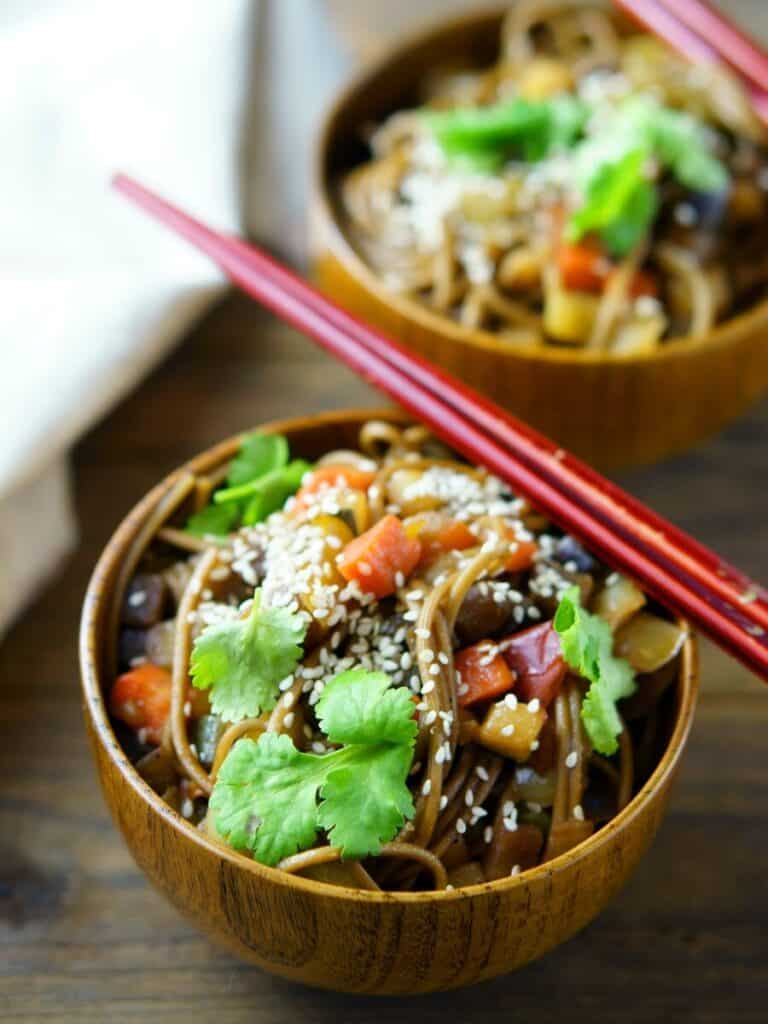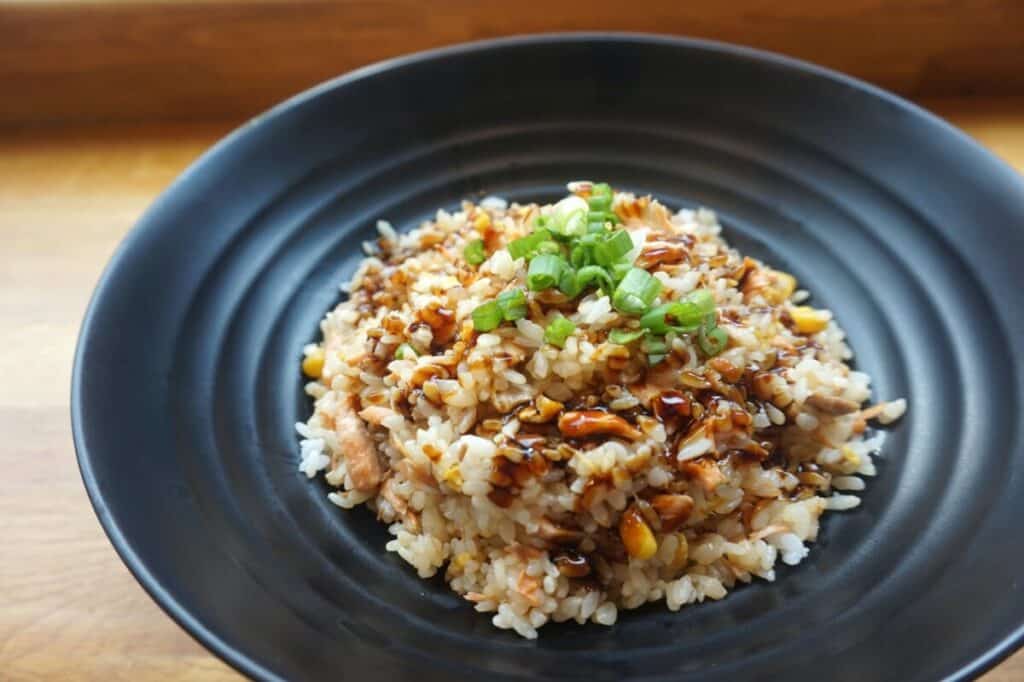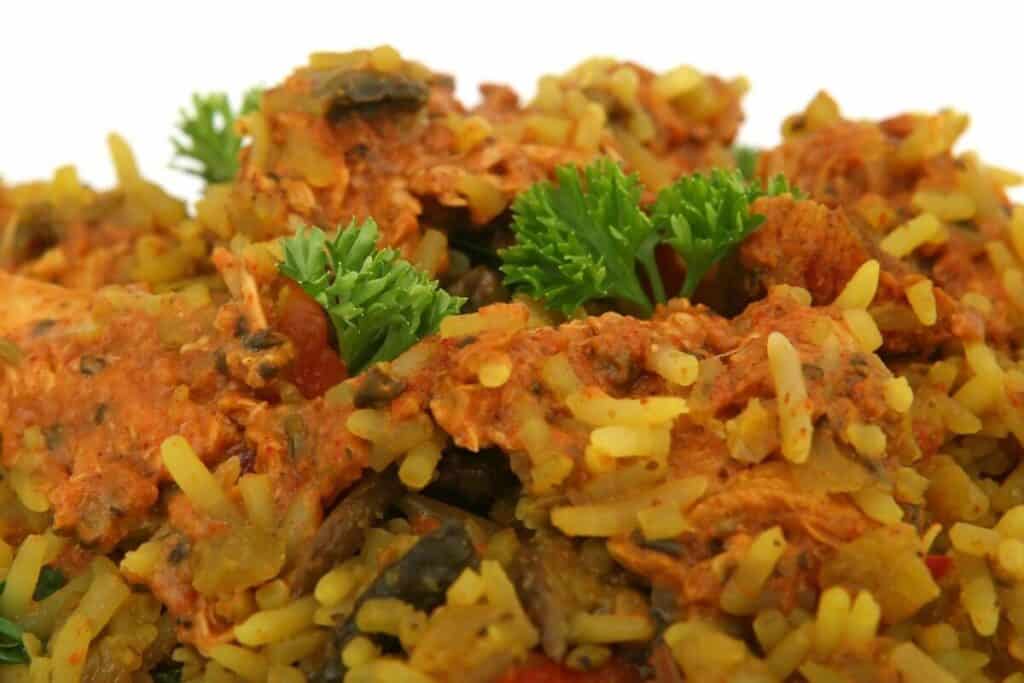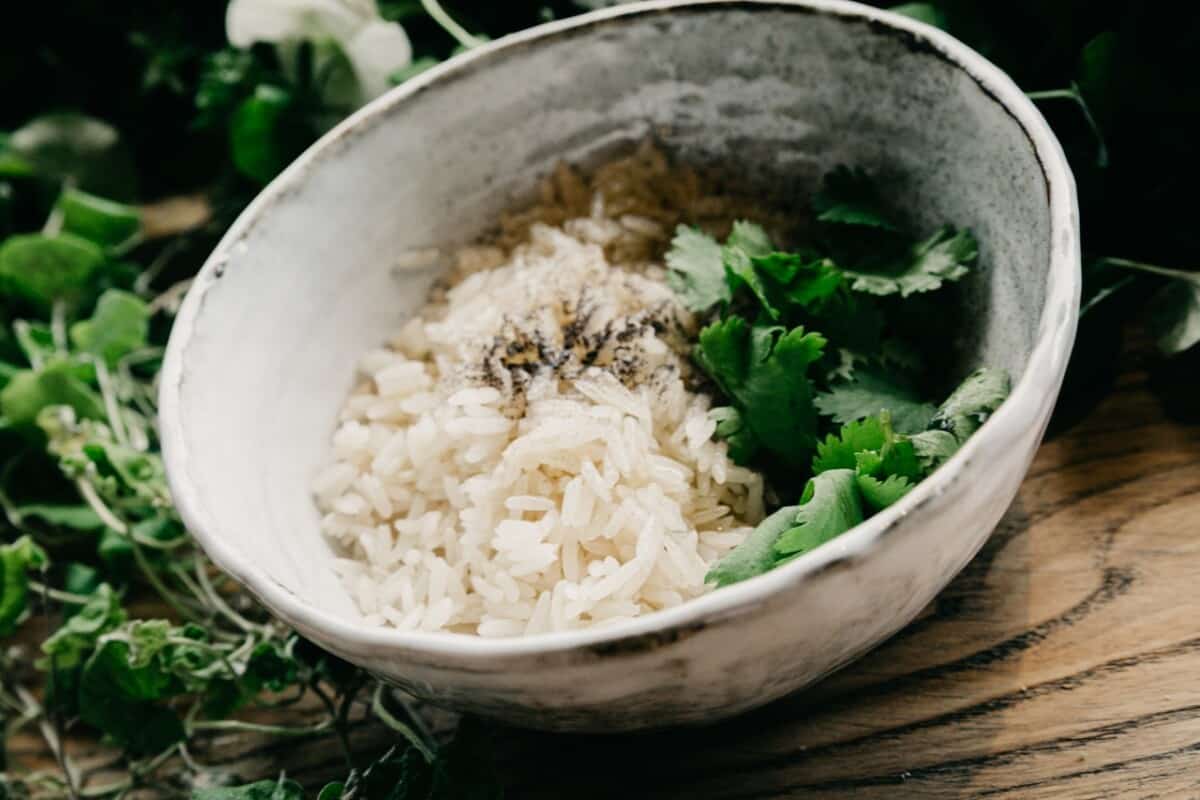Rice is the most widely consumed grain across the globe. Each different region in the world has come up with their own native delicacies over the centuries. About one-fifth of the world population depends on rice as a dietary source. It is a rich source of carbohydrates.
The biggest consumers of Rice being China and India are the home for multiple types of rice dishes. The most popular and simplest form of rice dish is boiling or steaming grains of rice and serving it with a curry on the side. There are a plethora of rice and curry options you can try, with recipes originating from different parts of the world.
Though rice-based dishes are famous in the Middle Eastern countries and South-East Asian countries, the majority of these recipes often include meat, fish or eggs.
A few European cuisines do have vegetarian versions, but predominantly is served with pork or beef. Same goes with American and Mexican rice dishes. Thus, despite being extremely popular, a large portion of these dishes are not vegetarian.
Thus, we have compiled a list of twenty rice dishes from different cookbooks across the world. You can either try these dishes in authentic restaurants featuring these tasty dishes, or you can try making them at your home.
Note: The origin of the dish is mentioned in the brackets alongside its name.
Bisi Bele Bath (India)
The first entry on our list, is a delicious spicy South Indian dish, originating from the state of Karnataka. The literal translation of its name is “hot lentil rice porridge”, which pretty much explains the dish accurately.
Made from rice, lentils, spices, ghee, vegetables and some coconut, Bisi Bele Bath is a wholesome meal which can be consumed as Breakfast, Lunch or even Dinner. Sometimes, to make it more extravagant, they top it with some roasted peanuts, or Indian Savory snacks (Bombay Mix, Spiced corn flakes or Khara Bhoondi). They are added on top to give the crunchy texture, to an otherwise soft, and Semi-Liquid dish.
Burasa (Indonesia)
It is an authentic rice dumpling dish originating from South Sulawesi, a part of Indonesia. It is made by packing half-cooked rice inside a pouch made from banana leaf and then steamed. Initially, to semi cook/boil the rice grains, they use coconut milk.
It is one of the more popular rice dishes native Muslims of Indonesia prepare during the end of Ramadan. Of course, many of the side dishes prepared by them tend to be non-vegetarian.
But the Buras/Burasa is fully vegetarian and are often eaten as a stand-alone savoury dish.
Bap (Korea)
Bap is the Korean rice-based dish cooked by boiling some short rice grains with an assortment of other grains and nuts. The most widely used grains accompanying the rice are barley, millets, sorghum or beans.
Bap is not a single dish. It is rather a classification of various similar dishes, with the differences popping in due to the addition of other special ingredients like Vegetables, seafood or sometimes meat. Among the various types of Bap, Chal-Bhap is the most well-known vegetarian dish.
It is a form of rice dish cooked using sweet grains of rice, dates, kidney beans or red beans, pine nuts, chestnuts and jujubes (Chinese dates/ red dates). Chap Bap is very famous in Korean Buddhist culture. Hence, it is widely consumed in their temples and monasteries.
The difference between these and other baps are Chal baps use brown rice, which is the glutinous or the unpolished version. Being rich in nutrients, the Bap is widely considered to be medicinal and energy giving food in Korean culture.

Curd Rice (India)
It is a native South Indian rice dish made using rice and curd (yoghurt). It is extremely simple to make but can be improvised if needed. It is prepared by mixing a pot of plain boiled rice with curd. But if needed, there are multiple variations of seasoning which can be added into the mix to elevate the taste of the curd rice.
Few of these additional optional ingredients are milk, chopped green chilies, fried lentils, mustard seeds, cumin powder and some chopped cilantro. Generally, a touch of salt is added if the curd is too sour.
If you prefer to serve a bowl of sweeter curd rice, alternate garnishing which can be added to the rice and curd mixture are pomegranates, grapes, raisins, grated raw mango and fried cashews.
If you prepare the simplistic version, a notable side dish you can enjoy it with is the Indian pickle, which is made from finely chopped vegetables (like raw mango, gooseberry, ginger garlic, lime, chickpeas, etc.) mixed with Indian spices and preserved in vinegar or edible oils.
Fried Rice (Asian)
Despite originally being a traditional Chinese Dish, the countries neighboring China have borrowed the recipe and have come up with their own style of making the dish.
This way Fried rice, made in India, China and Thailand are bound to taste different from each other. The fried rice has many versions, depending on the ingredients used, but all “veg or vegetarian fried rice” is void of any egg or meat.
Thus, while looking at the menu or the title of a recipe, the keyword to look out for is “veg”. It is usually prepared by cooking some “already steamed rice” in a wok with some soy sauce or other Chinese sauces and some diced vegetables.
The method of preparation of this dish is very similar to that of “Chinese Noodles”, where the pre-cooked rice replaces the noodles in the list of ingredients. The fried rice can be eaten as it is, or with a dip, or some sort of curry.
Jeera Rice (India)
One of the simplest recipes on the list, Jeera Rice is quite famous in Northern parts of India and Pakistan. It is quite old, as it dates back to being found in cookbooks from the Mughal Empire.
It is made using long grain rice, vegetable oil, cumin seeds, coriander leaves and some finely chopped onions.
Jiuniang (China)
Juiniang is sweet Chinese rice pudding. It is cooked using “partially cooked” brown rice and a traditional Chinese fermentation starter called “Juiqu”. Occasionally yeast is added if necessary.
This dish if let in open at a temperature above 10-15 degrees Celsius, undergoes fermentation and forms a rice wine, a traditional Chinese alcoholic beverage.
Thus, the dish is prepared for consumption, should be prepared and stored in a room below the fermentation temperature. This is why most Chinese people cook this dish during the winter season.

Khao Niao Mamuang (Thailand)
Thailand kitchens have come up with a variety of rice dishes, but only a couple of them are fully Vegetarian. Most of the sticky rice dishes start with “Khao…”, with the rest of the names changing based on the secondary ingredients.
Khao niao mamuang is made by cooking rice with coconut milk and serving them with mango on the side. Sometimes, to make it sweeter, sugar or jaggery is added to the coconut rice.
Cubes or slices of juicy mango pulp, along with the sweetened coconut milk rice, is a delicious must-try Thai rice dish.
Kheer (India)
Rice Kheer is a sweet delicacy, popular across India. It is a type of milk-based pudding, made using, rice, milk, desiccated coconut, sugar, cardamom, saffron, ghee, and dry fruits (cashews, almonds, raisins, pistachios, etc.).
Among the different types of rice, Basmati rice is generally preferred, as it makes the delicacy more flavorsome. It tastes good both hot and cold and can be served as a thick pudding or a thin drink.
This is done, by varying the quantity of milk added during the preparation of Kheer. Kheer is an important dessert during festive seasons as well as during special occasions like a Hindu wedding, etc. To make the dish creamier, people generally simmer the kheer over low flame for a while.
Khichdi (India)
Khichdi is extremely easy to prepare and wholesome meal from India. This one-pot meal is highly recommended to those who are sick, or suffering from flu, as it is easy to digest and is rich in nutrients.
It is a type of rice porridge, made from, plain white rice, black lentils, finely diced vegetables, turmeric powder, and ghee(optional).
The salt and spices are added as a seasoning, and their quantity varies with personal preference.
Kiribath (Sri Lanka)
This authentic Sri Lankan dish is more like a rice cake with coconut flavoring. It is a breakfast food served on the morning of the first day of every month, as well as on special occasions and festivals in Sri Lanka. This simple dish is prepared by boiling a pot of rice.
Once the rice is boiled, coconut milk is added to it and the pot is heated till the milk is absorbed. Then, the dish is seasoned with some salt and may or may not be garnished with some cashews and sesame seeds.
The dish is made authentically using clay pots, as it is believed, it imparts or affects the taste. The Kiribath can either be sweetened using jaggery and consumed or is served with any curry on the side.
Lemon Rice (India)
Lemon rice is a popular south Indian rice item. Alternatively, Poha is dish quite similar to the Lemon Rice but uses flattened rice flakes instead of actual rice. It is prepared by mixing a bowl of cooked rice with a special native seasoning and lemon juice.
This seasoning is made of mustard seeds, fried lentils, curry leaves, pepper, peanuts, oil and bits of raw mango (optional). After the rice is mixed with the seasoning, lemon juice is squeezed onto the mix and turmeric powder is added to it.
The turmeric powder gives the yellow coloring to the dish. Generally consumed as a breakfast food, the Lemon rice is a wholesome meal on its own but can be served along with some coconut chutney or fritters on the side.
Pongal (India, Sri Lanka)
Pongal is one of the most popular rice dishes in the state of Tamil Nadu. It is so popular. It is so famous, that one of the key highlights of their native harvest festival (also named “Pongal”) is the preparation of this delicious dish.
Pongal comes in two popular variants, sweet (termed as “sweet Pongal”) and spicy (termed as “Pongal” without a pre-fix, or as “Venn Pongal”), both being one-pot meals.
Though both the dishes can be consumed separately, sometimes, they are also served together, as they complement each other in terms of taste. The sweet Pongal is prepared by boiling rice in sweetened milk. Generally, cane sugar is added as the sweetening agent.
Additional ingredients used include coconut, cardamom, ghee, cashews, green grams and raisins. The Venn Pongal (spicy) is made from pepper, rice, salt, curry leaves and lentils, with some optional drops of ghee of top.
The spicy Pongal is a common breakfast food and is served along with some coconut chutney and some sambar. Optional sides are vadas (a native Indian snack) which go well with the Pongal.
Puliogare (India)
Puliogare is a tamarind-based rice dish originating from India. It is a simple and straightforward dish, which is known for its taste and its ease of storage.
It is spicy, tangy, flavorful, and remains fresh for more than a day. Hence, it is an ideal travel food, as you can prepare it in large quantities and consume it even hours later.
It is a simple stand-alone dish, which doesn’t any sides of any sorts. Puliogare is made from cooked rice, tamarind powder, oil, curry leaves, spices and salt, all mixed and cooked together.

Puttu (India, Sri Lanka)
A Kerala cuisine specialty is the puttu, a rice dish, consumed in Southern parts of India, and a few regions of Sri Lanka. This breakfast dish is generally served with a curry on the side.
These are cylinders of steamed rice, which can either be sweet or Savory, depending on the ingredients. All variants of this dish, have coconut trimmings mixed with the grounded rice. The other contents of the puttu are generally one of the following elements- jaggery, lentils, cumin, Indian spices, etc.
They taste great with a number of vegetable-based curries like “chickpea curry”, “mixed vegetable curry” or along with coconut milk or fresh fruits on the side (preferably, jackfruit, mango or banana). The dish on its own is completely vegetarian, but caution has to be paid with the side provided with it.
Spanish Rice (Mexico)
Despite what the name may suggest, the Spanish rice actually comes from Mexico. It is quite unknown to the people of Spain but has been popular in Iranian and Persian cuisine.
This Mexican dish is prepared using polished white rice in a pan or a skillet with some oil or Vegetable fat. It is then sautéed along with chopped tomatoes and some tomato sauce (or paste).
Generally, Mexican food restaurants serve it along with a side of beans or veggies of your preference. While cooking, the only aspect you have to be wary of the broth used. To cook the rice either use vegetable broth or just stick to water instead.
Vegetable Pulav (South Asia)
Vegetable Pulav/Pilaf/Pilau is known by many names across different parts of Asia. It is also, dubbed as “vegetable biryani” in Indian restaurants. It is cooked by boiling a pot of rice with some vegetables, salt, oil and some added spices.
Other seasonings like curry leaves are added if needed. Once the dish is almost done, roasted almonds or fried onions are added to the pulav.
It is served with a vegetable clear curry or with some Raitha, as a side dish. Raitha is a mix of yoghurt (curd) and some finely grated onions and cucumber.
Vegetable Risotto (Italy)
The most common method of cooking rice in Italy, the risotto is a creamy, flavorsome rice dish. Like the fried rice in Asia, the risotto has a wide range of both in vegetarian and non-vegetarian options.
Among them, the vegetarian risottos are made from vegetables, onions, cheese, butter and white wine.
Tahgid (Iran)
It is Persian rice dish, usually served along with any curry or stew. Made from yogurt, rice, potato, saffron, tomato and bread.
Fruits like sour cherry are also added into the mix the idea of the dish is to let the bottom layer form a thick hardened crust, which is supposed to the tastiest and flavor rich part of the dish.
Zarda (Bangladesh, India, Pakistan)
Zarda is popular rice sweet in the Indian Subcontinent. Served as a dessert in Muslim weddings, this tasty treat gets its name from its bright yellow color (zard= yellow in “Persian”).
Zarda has ingredients which are quite similar to those of Kheer, but are much drier in consistency. The quantity of milk used is minimal in Zarda. The dish is cooked till the rice absorbs most of the moisture content.
It is cooked using rice, milk, sugar, saffron, dried fruits and nuts. The key ingredient is the saffron, which gives the dish it’s yellow color.
Life coaches all over the world usually recommend these dishes for vegans to stay healthy and consume
all the vitamins that are necessary for the body.

